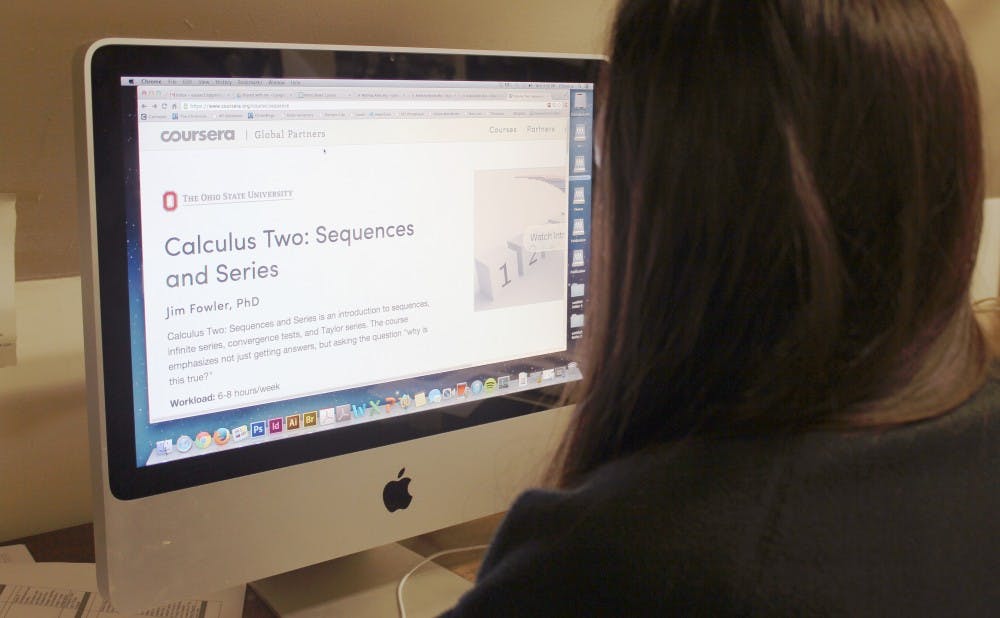As the use of the “flipped classroom” model rises on campus, students and faculty are taking time to adjust to the idea.
The “flipped classroom” concept requires students to learn the lecture and information prior to class so that they can apply their knowledge to practice sets and activities in class. Currently, there are a few Duke professors who have already adopted this technique and are witnessing improved student performance.
“If you keep up with it, you will absolutely not have to pull an all-nighter,” said Mohamed Noor, Earl McLean professor and associate chair of biology.
The biggest apparent advantage to the “flipped classroom” model is its more dynamic and engaging environment, Noor said. This is what he created in his course, Biology 202L. The flipped classroom model is significantly different from the stereotype of a lecture hall filled with hundreds of students and one professor at the front, relaying information on the chalkboard while students take notes, struggle to pay attention or even sleep.
“There is more time talking to the students [in a flipped classroom], which is more rewarding,” Noor said.
Some concepts do take a while to get across, so giving students the opportunity to read material at their own pace and at their own time allows for better understanding, Noor added—the idea should seem more appealing than an 8:30 a.m. lecture to many students. He believes he definitely saw an improvement in student performance after he switched to the “flipped classroom.” For the first test in the Spring semester, students did better in 2013 with the flipped classroom than in 2012 when the class was still in lecture format, Noor noted.
Although the exact number of professors who utilize the “flipped classroom” method is hard to measure, there has been a “definite” increase in its use over the past three years, said Keith Whitfield, vice provost for academic affairs.
“We are working to help faculty understand the strengths of this approach but are limited to who we know are doing these sorts of classes,” Whitfield wrote in an email Wednesday.
Stephen Craig, professor of Chemistry 110, believes that the biggest benefit—along with student interaction—is that the model allows students to discuss alternative views.
“Lectures do a wonderful job of explaining the ‘Why?’” Craig noted. “But we should also focus on the ‘Why not?,’ considering alternative ideas and possibilities and discuss why a certain view has more merit than another.”
Steve Nowicki, dean of undergraduate education, believes that the future of this concept looks promising.
“Any course that has a significiant amount of content just lends itself to this,” Nowicki said. “Eventually, students are going to expect this.”
Especially for introductory science courses, the flipped classroom concept would be effective since there is an enormous amount of factual content, Noor noted.
“You’re flipping the way information transfer and understanding are happening,” Nowicki said.
Though the “flipped classroom concept” seems promising, both Nowicki and Noor noted that not all professors are inclined to make the transition. The upfront investment for flipped classrooms is very high, and that for many it is easier to just keep on teaching as they have in the past, Noor said. Professors are responsible for creating their whole curriculum before the course even starts, such as recording lectures. It is easier in the end, however—no need to teach the same lecture to multiple class sections if students can watch the lecture online, Nowicki added.
On the other hand, the student reactions are mixed.
“Students are on their own,” said freshman Alexander Chen, a Chemistry 110 student. “They are less likely to ask the professor questions. It does increase student motivation, though.”
Chen noted that student learning in a flipped classroom is very independent. At times, it can be quite a commitment for students to watch all of a 30-minute lecture prior to the class.
“It is way different than a lecture class because our interactions in the class are based on practical use,” said freshman John Victor Alencar, another Chemistry 110 student. “Some students would prefer lecture because they feel they’re not getting enough substance since they have to learn by themselves.”
Noor does agree that there is a high level of effort involved, from both the student and faculty. But he also pointed out that if the students keep up with it, it will become easier in the long run. Students can better understand the material earlier on so that they do not have to memorize the night before an exam.
Nowicki is hopeful that the “flipped classroom” will flip the way students learn for the better.
“Good teachers are always working to improve the way they teach,” Nowicki said, “and the flipped classroom is one innovation that a number of our best faculty are using to take their teaching to the next level.”
Get The Chronicle straight to your inbox
Signup for our weekly newsletter. Cancel at any time.

